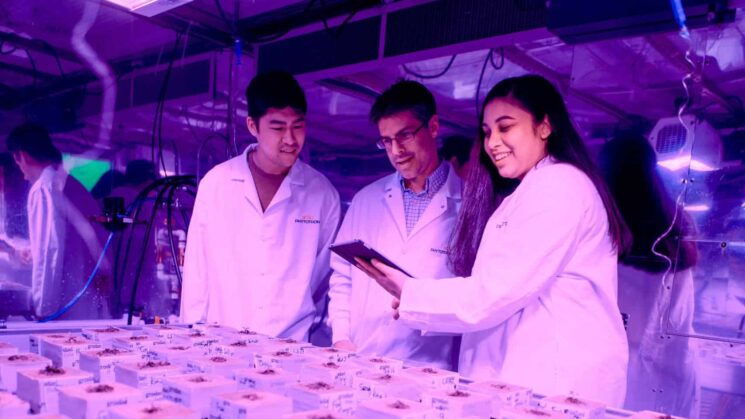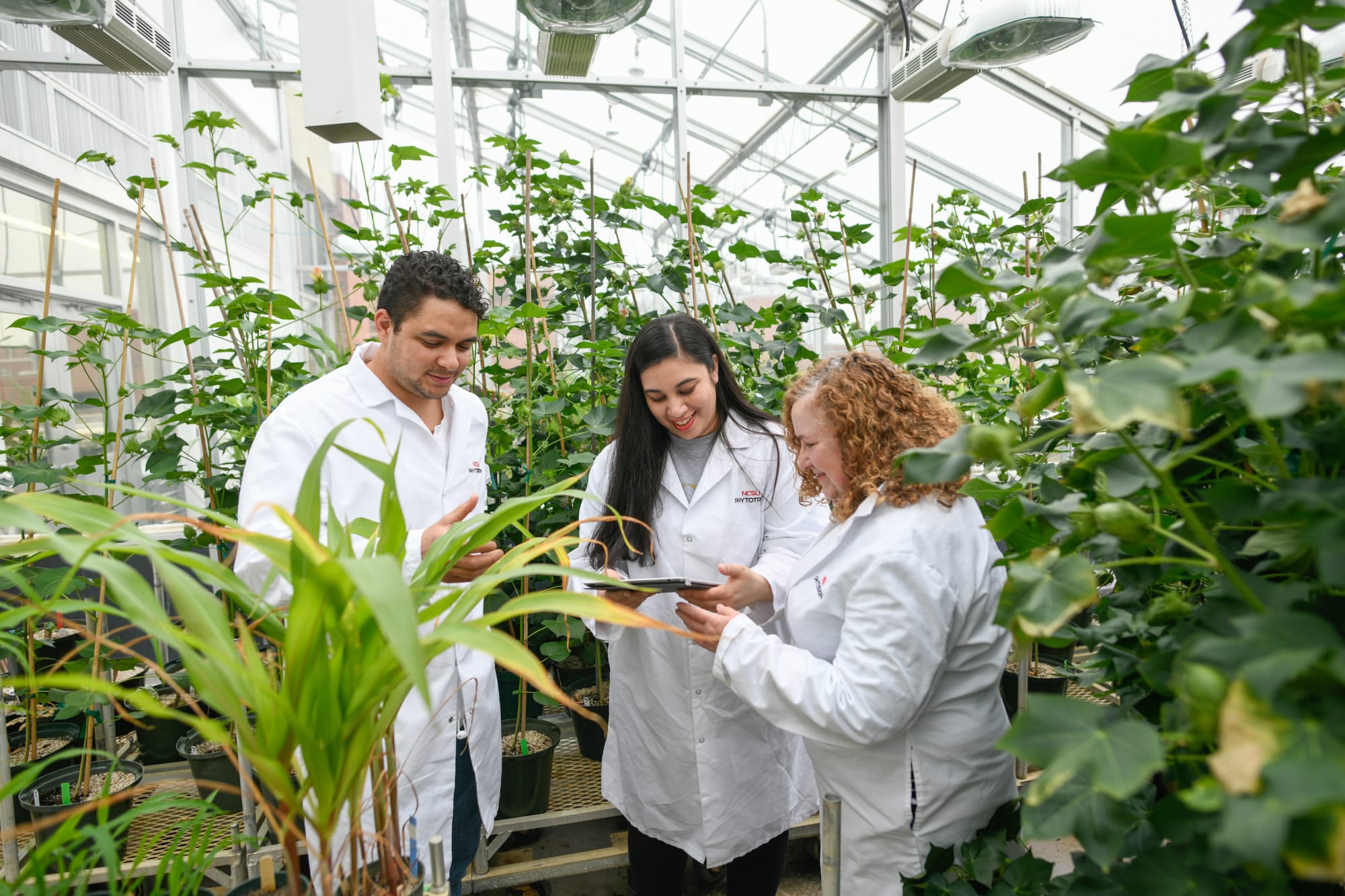

Jabeen Ahmad in lab with colleagues
Written by: JABEEN AHMAD, AGBioFEWS Fellow & FFAR Fellow
*Note: This blog post originally appeared on the FFAR website. The opinions expressed in this article are those of the author individually and should not be taken as a reflection of the views of the whole of the Genetic Engineering and Society Center or NC State University.
Food insecurity is a concern now and in the future. Globally, the United Nations estimates that about 690 million people are food insecure.
By the year 2050, the world population is expected to reach nine billion people, requiring food supplies to double. While the demand for food grows, fertile, arable land is decreasing and extreme weather events are increasing, making the task of feeding everyone more difficult. With climate change, the problem is further exacerbated as pest and pathogen ranges expand and habitable zones for crops change. Plants need to be stronger and hardier. At the same time, we need to implement more sustainable crop management practices that lessen chemical inputs such as fertilizers and pesticides. The challenge seems intractable.
Enter microbes. Plant growth-promoting (PGP) microbes beneficially interact with plants, enhancing their growth and development while helping them survive and thrive under stressful or adverse conditions. PGP microbes help plants absorb nutrients and boost their immunity and defend against pests, thus supplementing or replacing fertilizers and pesticides. We have been able to identify and determine the function of a small number of plant and soil microbes, the majority of which are bacteria and fungi. These well-known microbe helpers work closely with plants to promote growth, development and resilience. The focus of my research at North Carolina State University is on related but lesser-known organisms — archaea, fascinating forms of life that could play a revolutionary role in helping us increase the supply of sustainably grown food.
Archaea are single-celled organisms with unique characteristics that distinguish them from bacteria and eukaryotes. Many archaea are known as extremophiles, living in some of the most extreme environments such as the boiling acidic hot springs of Yellowstone National Park, the sea ice, permafrost and polar regions of the Arctic and Antarctic, the hypersaline desert lands of Tunisia and the deep-sea hydrothermal vents and trenches off the coast of Iceland. Archaea also have novel pathways for nitrogen fixation, methanogenesis, phosphorus solubilization and chemosynthesis, which allow for discovery of new beneficial processes and molecules.
My area of research expands on the knowledge of PGP archaea by identifying and determining the function of soil- and root-colonizing archaea in wheat. By being able to effectively live in adverse or stressful conditions, archaea maintain the functionality of the soil, plant and microbial system, giving plants what they need while buffering them from environmental conditions that can cause harm. My research seeks to better understand how we may be able to harness the super heroic features of archaea to boost plant growth and development while enhancing tress tolerance and increasing pathogen resistance.
As part of the INTERACT project of the Collaborate Crop Resilience Program, I am examining the root and soil microbiome in wheat. My research involves growing four varieties of wheat under normal growing conditions and stress conditions to observe and understand how the microbiome develops and evolves. I also collect samples of soil and wheat roots from various environments across North Carolina where soil type and climate conditions differ. Using these diverse samples, I will try to isolate different kinds of archaea. With the isolated archaea, I focus on identifying and determining the function of wheat-associated archaea to discover what beneficial traits they possess to promote growth and development, to resist abiotic and biotic stresses and to interact with wheat and other microorganisms. My research will not only provide greater insight on archaeal organisms and metabolisms but also on the role that archaea play in the soil and root microbiome. Identifying and understanding wheat-associated archaea is the first step to leverage their abilities to improve plant growth and development, improve soil health and increase the global food supply. By combing through soils and roots, we can find archaea with important PGP properties that can be used as a support or alternative to pesticides and fertilizers while also increasing crop yields and improving soil health. Our microbial superheroes can help to feed a growing population, restore our soils and improve the health of our plants.
The FFAR Fellowship has been an important part of my doctoral journey, and I am grateful to North Carolina State University and my industry sponsor Saliwanchik, Lloyd & Eisenschenk for their support and encouragement. As a doctoral student, I am focused on learning the scientific principles and technical details of my research, but developing that knowledge also relies on strong communication, effective teamwork and meaningful connections. Through the FFAR Fellowship, I have improved my skills in these areas and established relationships with professionals outside of academia that I hope will continue well beyond my time as a fellow.
Jabeen Ahmad is an AgBioFEWS Fellow, a FFAR Fellow, and a doctoral student in Plant Biology at NC State University. Jabeen is a member of the Grunden Lab where her research focuses on plant-microbial interactions and exploring the wheat root microbiome. Her passion for food security motivates her research on the microbiome as a way to address food and nutritional insecurity now and in the future. She can be reached at jahmad2@ncsu.edu.

